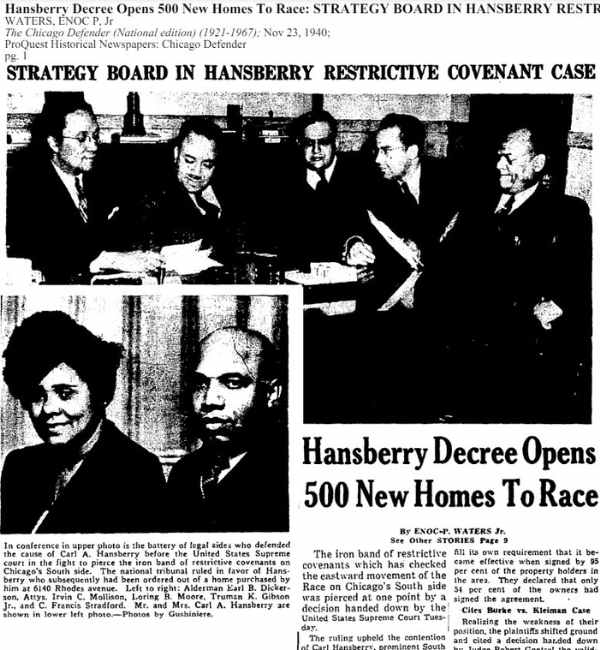This collage details how Black segregation from the past has fueled the homegrown crises of Black homelessness and affordable housing scarcity (Credit: Christa Carter-Williams).
This is Part One of the Chicago Defender’s series Black and Unhoused: How Segregation Fueled a Homegrown Crisis, which is part of the “Healing Illinois” initiative.
Two of the greatest works of literature have documented Black people’s struggle to attain stable, affordable housing in Chicago.
Poet Gwendolyn Brooks’ seminal poem “Kitchenette Building” chronicles how the dreams of its residents, products of the Great Migration, lived in a subdivided dwelling constricted to a section of the South Side by law and conspiracy. Their aspirations compete with the grim realities of their existence, where aspirations must contend with “… yesterday’s garbage ripening in the hall.”
Richard Wright’s “Native Son” opens with the gruesome scene of a giant black rat infiltrating a family’s one-room kitchenette, forcing the protagonist, Bigger Thomas, to kill it with an iron skillet. While the animal is symbolic in that its death will foretell the fate of Bigger, it also speaks to the conditions Black families had to contend with in Chicago’s Black Belt.
[perfectpullquote align=”full” bordertop=”false” cite=”” link=”” color=”” class=”” size=””]Yet, when it comes to the Black struggle to attain stable and affordable housing, one origin story that inspired a revered play is very much connected to the predicament of Black homelessness we see today. [/perfectpullquote]
It was a true story that began with one man’s vow: to fight against a local law that bound Black people in Chicago to within 27 square miles of space, an area replete with substandard, high-rent housing.
Carl Hansberry, a real estate broker and banker, was aggrieved at the conditions caused by restrictive covenants or the language in a housing deed or lease limiting who could buy or rent in specific neighborhoods.
In this instance, it was Black people who, due to a racially restrictive covenant drafted by Chicago lawyer Nathan William MacChesney in1927, could not live in the White neighborhoods adjoining the Black belt, like Hyde Park and Kenwood and even communities to the west occupied by Irish, Polish and Italian immigrants.
Instead, many families were forced to cohabitate in cramped quarters in buildings unfit for living. Whole families called single-room dwellings home.
“By the fall of 1936, the housing shortage was so acute due to the above causes, and the fact that restrictive covenants prevailed in all areas bounding the colored sections,” Hansberry wrote in The Defender in November 1940, “that I decided some efforts should be made to relieve the congested situation.”
He determined that the most vulnerable place to attack the covenants was targeting the areas where the “pressure was the greatest,” west of Cottage Grove, north of 63rd Street and south of 60th Street.
“It was with this view of making this area immediately available to the colored citizens of Chicago that the fight was started, and for the further purpose of trying to have the theory of restrictive covenants once and for all abolished, or declared as against the public policy of the state and nation,” he wrote.
That fight occurred three years before the publication of that Defender article when Hansberry bought a home at 6140 Rhodes Ave. in the predominantly White neighborhood of Woodlawn.
Like in other instances where pioneer Black families attempted to move into White neighborhoods, the Hansberrys were greeted by a mob. The group threatened their lives, and Hansberry’s wife, Nannie, had to patrol the house with a gun.
But in June 1937, a neighbor named Anna Lee and others pursued legal means to have the Hansberrys removed from the property due to the district being racially restricted.
The Hansberrys and others were charged with conspiracy to violate an agreement restricting the transfer of property in that area to Whites only, and Illinois courts upheld the finding, forcing them to vacate.
However, petitions were filed in 1940 to hear the case in the U.S. Supreme Court.
The highest court ruled in favor of Hansberry, but it was not based on the constitutionality of the restrictive covenant.
Instead, it ruled that the agreement was invalid because it did not meet the threshold requiring 95% of property owners in the neighborhood to sign the legally binding deed to keep out Black families. Only 54% did.
On that technicality, about 500 homes were opened up for Black people to move to in the formerly restricted area.

A 1940 Chicago Defender article chronicled Carl Hansberry’s historic Supreme Court victory, which freed up 500 homes for African Americans.
However, the historic ruling did not abolish the covenants nor the practice of housing discrimination as Hansberry intended.
It would take nearly three more decades before covenants were outlawed by the Fair Housing Act of 1968.
Ultimately, Hansberry’s fight was a partial victory.
However, it inspired another literary work documenting the Black housing struggle in Chicago. It was a play called “Raisin in the Sun,” written by Hansberry’s daughter Lorraine, about the travails of a Black family that purchases a home in an all-White Chicago neighborhood.
If there is a lingering theme about “Raisin” that also applies to the import of the denial of Black families to stable, affordable housing, it is this by literary critic Lee Jacobus:
“This play illustrates the American dream as it is felt not just by African Americans but by all Americans: If you work hard and save your money, if you hold to the proper values and hope, then you can buy your own home and have a kind of space and privacy that permits people to live in dignity.”
Eighty-four years after the Hansberry ruling and 56 years after the passage of the Fair Housing Act, a predominant story remains: that affordable housing in Chicago remains elusive, especially for almost 70% of the non-asylum seeking Black homeless population.
VIDEO STORY: Black and Unhoused in Chicago: How Housing Segregation Fueled a Homegrown Crisis
This article is part of the Segregation Reporting Project, made possible by a grant from Healing Illinois, an initiative of the Illinois Department of Human Services and the Field Foundation of Illinois that seeks to advance racial healing through storytelling and community collaborations.
The project is inspired by “Shame of Chicago, Shame of a Nation,” a new documentary that addresses the untold legacy of Chicago’s systemic segregation.
Managed by Public Narrative, this endeavor enlisted five local media outlets to produce impactful news coverage on segregation in Chicago while maintaining editorial independence.




